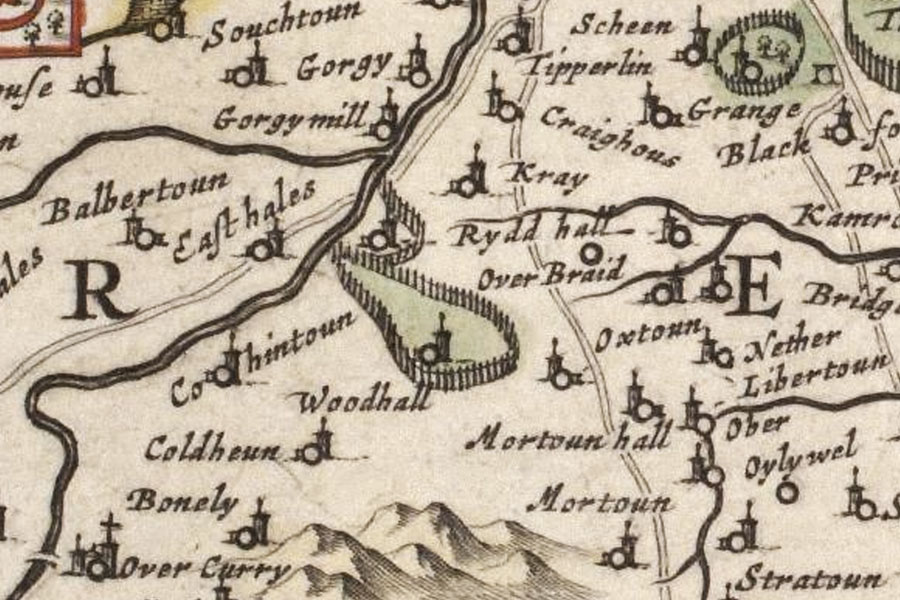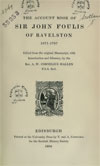

Woodhall House is a 17th century mansion, remodelled in the 19th century, that is either built on the site of or close to a much older tower house.
Woodhall is first mentioned in a charter of 1329, at which time it was Royal land, a part of the Barony of Redhall, and at this time it was leased to an Alexander Menzies (or Meygners). It is said that Woodhall (and Bonaly, another part of the Barony of Redhall) were “part of the ancient estate of the Denniestons”, so it may have been the Dennieston family.
The Woodhall estate originally straddled the Water of Leith, stretching as far north as the edge of Currie Muir and as far south as the lower slopes of Torphin Hill, with the house standing midway, just to the south of the river.
Sir William Cunningham, Laird of Kilmaurs (also written as Sir William Cunyngham, Laird of Kilmawrs), married Margaret Dennieston (or Danielstone) some time in the late 14th century, and at this point the lands of Bonaly and Woodhall seem to have passed into the Cunningham family. Their son, also William, was born around 1395, and is variously styled as “of Cunninghamhead” (another Cunningham property in Ayrshire) or “of Bonaly” (or Bonnalay).
Little mention seems to be known about the tower house, but it was three storeys in height with the basement floor being vaulted basement, and there was a shot-hole in the south wall for defence. In the western most vaulted chamber is a four-centred arch fireplace with side chambers.
In 1629 Adam Cunningham, later Lord Woodhall, built a new house at Woodhall, incorporating parts of the old tower house. As Woodhall currently stands, the west end is part of the earlier tower, and retains its vaulted basement. Extending to the east is a three bay three storey house, which is thought to be late 16th or early 17th century in date, so may have been built by Cunningham.
The east end of the old tower seems to have been incorporated within the west end of the new house, as the ground floor of the western portion is vaulted. An old doorway at ground level, giving access to the basement, is thought to pre-date Cunningham’s new house, while to the left of it is a 17th century panel surmounted by a pediment. In the western most ground floor room is a fine plaster ceiling, thought to date from around 1630.
Woodhall remained in the Cunningham family until 1697, when Sir John Foulis of Ravelston married his third wife Mary Murray, the widow of John Cuninghame of Enterkin, and bought Woodhall from Cuninghame’s heirs.
The estate was apparently in debt at that time, and Foulis set about improving it, making it the seat of the Foulis family. From his son William descended the Foulis of Woodhall branch of the Foulis family. Sir John died at Woodhall in 1707.
At some point in the 18th century a garden was laid out, surrounded by a wall, and at its centre was a polyhedron sundial, dated 1717.
Woodhall passed through several generations of the Foulis family, eventually being inherited by William’s great-grandson, Sir James Foulis, 7th Baronet of Colinton, in 1796.
Sir James was responsible for remodelling Woodhall, in work beginning around 1815 and lasting until 1820, recasting the façade in a Georgian style. At the centre of the main block he added a three storey crenellated square tower with a wide staircase giving access to a grand new entrance at first floor level. A new wing was added to the rear of the building, extending approximately north from the east end of the building to form an L-shape.
Sir James apparently only lived at Woodhall during the summer. After his death in 1842, Woodhall was let to tenants. Interestingly in 1775 an advert in the Edinburgh Advertiser seems to suggest that Woodhall was owned at that time by William Sinclair of Rosslyn:
To be let, the Mansion House, Offices, Dovecot and gardens of Woodhall, with two large grass parks adjacent thereto, lying at the distance of only four measured miles west from Edinburgh, within the parish of Colinton; agreeably situated on the Water of leith, and on the side of a good turnpike road from Edinr., all presently possessed by Wm St Clair of Roslin Esq.
Edinburgh Advertiser
Edinburgh, 11th July 1775
This may suggest that Woodhall was also let prior to Sir James’ death, although the advert does imply that William Sinclair was the owner at that time. In any event, Woodhall passed to his son, Sir William Liston-Foulis, 8th Baronet of Colinton, in 1842, then to William’s son, Sir James Liston-Foulis, 9th Baronet of Colinton, in 1858.
Another Sir William Liston-Foulis, 10th Baronet of Colinton, inherited the house in 1858, but continued let it out, and never lived there.
Until the 1870s the main vehicular access to Woodhall was via a ford across the Water of Leith, but around this time it seems that a driveway was built to allow an approach from the east.
Following the 10th Baronet’s death in 1918 Woodhall passed to Sir Charles Liston-Foulis, 11th Baronet of Colinton, who in 1931 sold it to a Ross-shire farmer named George Eric Glendining, who in turn sold it to Sir Stanley Davidson, Professor of Medicine at Edinburgh University, in 1938.
In 1959 Davidson sold Woodhall to the Society of Jesus, a Jesuit foundation, for £8000, and they added a massive, and rather ugly, accommodation block to the east of the house in the 1960s.
The Jesuits sold Woodhall to an Edinburgh businessman in 1976, and it became a family home again. The neighbouring accommodation block was sold off and converted into flats in 1982.
In 2007 a planning application was submitted, proposing to convert Woodhall into five flats. The proposed conversion sounds less than sympathetic, and would have included a new stair tower to the rear which would have covered windows, the installation of dormer windows in the roof, new windows in the walls not in keeping with the building’s style (which would also have affected the Georgian interior decorations), and various modifications, removals and subdivisions of Georgian and 17th century features and rooms.
Despite Historic Scotland’s overwhelming, and strongly-worded recommendation that permission for conversion should be rejected, amazingly the City of Edinburgh Council’s Planning Committe granted listed building consent.
Luckily it seems that the plans didn’t go ahead, as the building doesn’t seem to have been converted. Woodhall appears to have changed hands again, and in 2011 the new owners commissioned the architect Lorn Macneal to carry out a sympathetic refurbishment with a small garden room extension, which was completed in 2012.
Alternative names for Woodhall
Wodhalle; Woodhall House
Where is Woodhall?
Woodhall is in the parish of Edinburgh and the county of Midlothian.
Grid reference: NT 19729 68348
Lat / long: 55.901514, -3.285352














